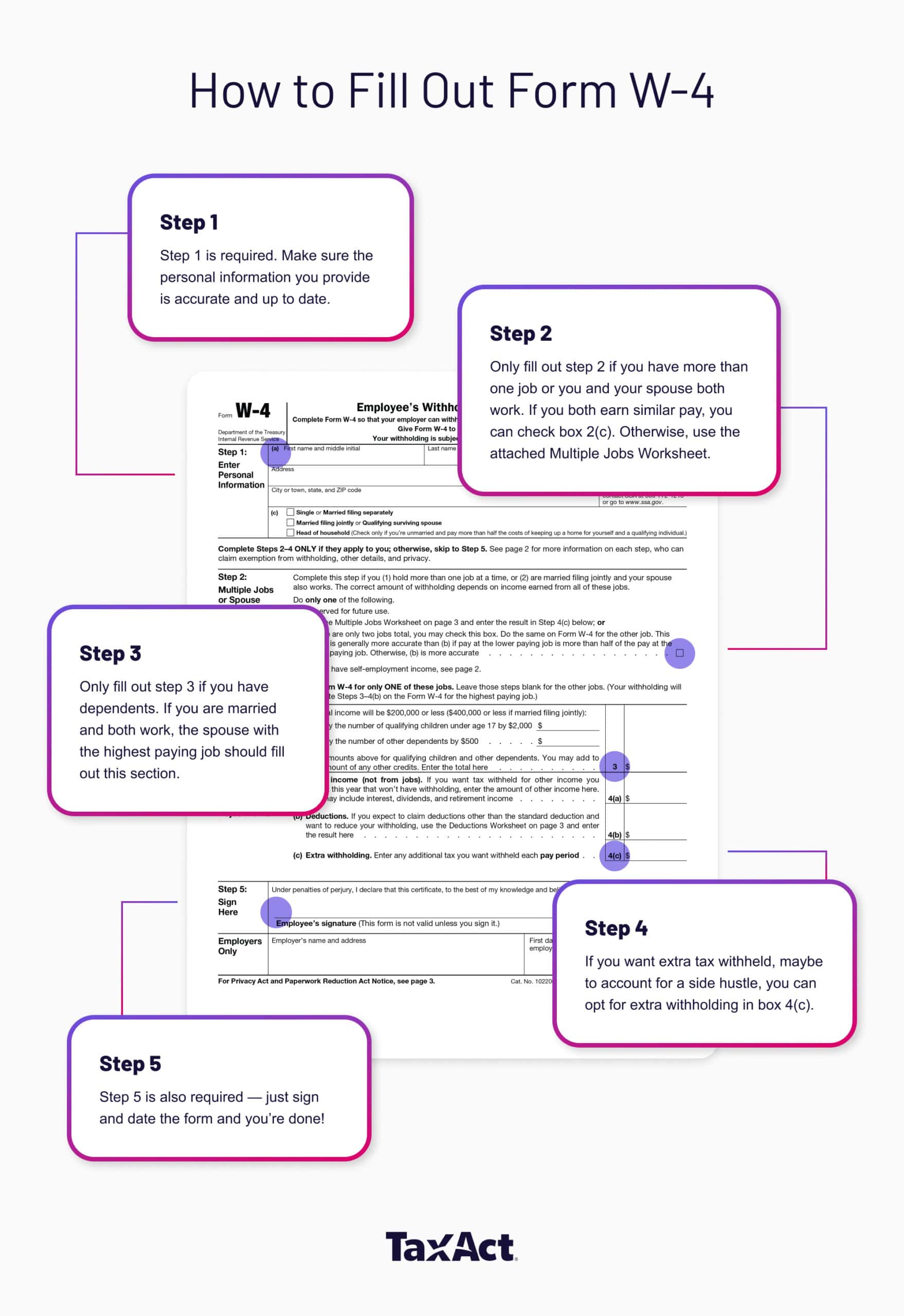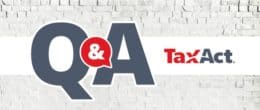How to Fill Out Form W-4 to Keep More Money in Your Pocket


File your taxes with confidence.
Your max tax refund is guaranteed.
At a glance:
- Form W-4 tells your employer how much tax to withhold from your paycheck.
- You should adjust your W-4 form after major life events such as getting married or having a child.
- If you want a larger refund you can choose to withhold extra money from your paychecks.
Let’s face it, the Form W-4 pre-2020 was confusing. You had to claim allowances on your W-4 form to determine your tax withholding amount, but most people didn’t really know what these numbers meant.
The current W-4 form has done away with all that. Now, it’s much more straightforward and designed to give taxpayers the most accurate withholding. Ideally, this means you’re more likely to have less taxes taken out of your paycheck and more money in your pocket without owing a huge tax bill at the end of the year.
Ready to learn how to fill out a W-4 form? Let’s dive right in.
What is a W-4 tax form?
Your W-4 form tells your employer how much federal income tax to withhold from your wages every pay period. Using the information you provided when filling out the form, your employer will determine how much tax to withhold from your paycheck.
After filing your tax return, a smart financial move is to double-check your Form W-4. Ensuring you have the right amount of tax withheld from your paycheck can make a big difference in your tax outcome next year.
If you have too much federal income tax withheld, you may receive a huge tax refund. While this may sound like a good thing, getting huge tax refunds every year likely means you’re not making the best use of your paycheck. Instead of receiving a big tax refund, you could be getting that money sooner by having less tax withheld from your salary.
In contrast, if you have too little tax withheld, you could face a large tax bill when you file. Additional penalties and interest could tack onto that total as well if you didn’t pay enough of your tax liability throughout the year.
So how can we find a happy medium? When it comes to your personal finances, it’s important to take the time to learn about tax forms, like Form W-4, to help you make the most of your money.
To help you navigate the process, below are the answers to some frequently asked questions about Form W-4.
Who needs to fill out a W-4 form and why?
The IRS requires every employee to fill out a W-4 form because it tells your employer how much income tax to withhold from your paycheck.
Why does my employer withhold so much from my paycheck?
The truth is your employer has no discretion over how much tax is withheld from your pay.
Every employer is required to withhold the amount that corresponds with the IRS withholding tables. The table is broken down based on your pay, the pay period (i.e. weekly, bi-weekly, semi-monthly), and the information on the Form W-4 you completed.
What happened to withholding allowance numbers on the W-4?
Prior to 2020, a withholding allowance was a number on your W-4 form that your employer used to determine how much federal and state income tax to withhold from your paycheck. The more allowances you claimed on your Form W-4, the less income tax would be withheld from each paycheck.
Beginning in 2020, the IRS completely reworked Form W-4 to accommodate some major tax law changes. Because of a large increase to the standard deduction, there is no longer a need for personal exemptions on a W-4 form. Keep reading for more information on how to control how much withholding is taken out of your paycheck.
How do I fill out Form W-4?
The W-4 form requires basic personal information, like your name, address, and Social Security number. Previously, the number of allowances and your tax filing status determined how much income tax was withheld from your pay.
Now, it’s much simpler than that. The new Form W-4 provides taxpayers with different sections to fill out depending on your tax situation (see the image below). When filling out the form, you only need to complete the steps that apply to you.

You can submit a new W-4 whenever you like. It’s always a good idea to review and adjust your W-4 withholding after major life events that may impact your tax liability such as getting married, having a child, or receiving a big raise.
What should I claim on my W-4?
You no longer need to claim allowances on your W-4 form, but there is a section for claiming dependents in Step 3. This section allows you to list all of your dependents, making sure the appropriate Child Tax Credit amount is deducted from your withholding. Fill out this section if you are the sole earner, or if you are married filing jointly and have the highest-paying job. If you are single with multiple jobs, you would also only need to fill out this section for your highest-paying job.
Is there a W-4 calculator I can use to help me fill out my form?
Yes! Whether you want more money in your refund or more money in your paychecks, you can use the TaxAct withholding calculator to see how changes to your W-4 form will impact your take-home pay.
How do I change my withholding on the W-4?
The new W-4 form was designed to create the most accurate withholding for all taxpayers. If you want your tax bill (or your tax refund amount) to be as close to zero as possible, it’s important you are claiming the correct number of dependents in Step 3 and including precise numbers for any additional income (such as retirement income, self-employment income, etc. earned by you or your spouse) in Steps 2 and 4.
If you itemize your deductions, don’t forget to account for any additional deductions in Step 4 of your W-4 form.
If you are someone who likes receiving a bigger tax refund with your annual return, changing your W-4 form to get more money with your refund is easy. You can choose what additional amount, if any, you want withheld from each paycheck on line 4(c) of the W-4 form.
Is it better to have more earned income withheld, just to be safe?
There are some downsides to letting the IRS hold your money for a year or more. For one, processing returns can take a while, and you could have had that money in your bank account sooner.
You wouldn’t overpay your mortgage, electric bill, or any other expense by thousands of dollars just so you could get a big refund at the end of the year, right? Yet, we have normalized doing this with our taxable income.
Think about it this way: When you elect to withhold additional tax from your paychecks, you are essentially giving the government an interest-free loan . . . but would they ever allow you to borrow money without charging interest?
On the other hand, many people choose to have extra withholding from each paycheck because it feels safer than the risk of receiving an unexpected tax bill at the end of the tax year. If withholding extra gives you peace of mind, then do what works for your unique financial situation.
Plus, if you are someone who struggles with saving, withholding extra money from your paychecks and getting it all back in one lump sum at the end of the year can be a helpful way to save your cash without the temptation to spend it all immediately.
Whatever you choose, it’s nice to know you are in control of your money!
How do I get a copy of my W-4 form?
To receive a copy of your W-4 form, just reach out to your human resources or payroll department. It’s always a good idea to review and adjust your W-4 form withholding after major life events that may impact your tax liability such as getting married, having a child, or receiving a big raise.
How do I file a new Form W-4?
Your payroll or HR department can supply a new form for you to fill out. Many employers provide an easy way to change your W-4 form online, or you can also print the form directly from the IRS website. The IRS W-4 form also provides a Multiple Jobs Worksheet and a Deductions Worksheet to help you calculate an accurate withholding if these circumstances apply to you.
Once you complete the form, don’t send it to the IRS — just give it to your payroll or human resources department to file.
Understanding and optimizing your tax-related documents, such as the W-4 form, is crucial for managing your finances effectively. The W-4 form dictates how much federal income tax your employer withholds from your paycheck. It’s essential to review this form periodically, especially after significant life events, to ensure accurate withholding.
Using a Tax Calculator, like the one provided by TaxAct, adds an extra layer of precision to this process. Whether you want a larger refund or more money in your paychecks, the Tax Calculator helps you visualize how adjustments to your W-4 form impact your take-home pay.




